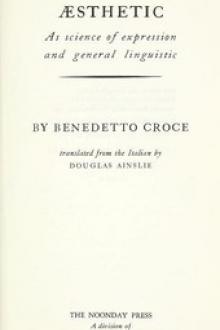The Sense of Beauty by George Santayana (ebooks children's books free .TXT) 📖

- Author: George Santayana
- Performer: -
Book online «The Sense of Beauty by George Santayana (ebooks children's books free .TXT) 📖». Author George Santayana
An answer to this question has been suggested by various psychologists. The eye, by an instinctive movement, turns so as to bring every impression upon that point of the retina, near its centre, which has the acutest sensibility. A series of muscular sensations therefore always follows upon the conspicuous excitement of any outlying point. The object, as the eye brings it to the centre of vision, excites a series of points upon the retina; and the local sign, or peculiar quality of sensation, proper to each of these spots, is associated with that series of muscular feelings involved in turning the eyes. These feelings henceforth revive together; it is enough that a point in the periphery of the retina should receive a ray, for the mind to feel, together with that impression, the suggestion of a motion, and of the line of points that lies between the excited point and the centre of vision. A network of associations is thus formed, whereby the sensation of each retinal point is connected with all the others in a manner which is that of points in a plane. Every visible point becomes thus a point in a field, and has a felt radiation of lines of possible motion about it. Our notion of visual space has this origin, since the manifold of retinal impressions is distributed in a manner which serves as the type and exemplar of what we mean by a surface.
Values of geometrical figures.
§ 21. The reader will perhaps pardon these details and the strain they put on his attention, when he perceives how much they help us to understand the value of forms. The sense, then, of the position of any point consists in the tensions in the eye, that not only tends to bring that point to the centre of vision, but feels the suggestion of all the other points which are related to the given one in the web of visual experience. The definition of space as the possibility of motion is therefore an accurate and significant one, since the most direct and native perception of space we can have is the awakening of many tendencies to move our organs.
For example, if a circle is presented, the eye will fall upon its centre, as to the centre of gravity, as it were, of the balanced attractions of all the points; and there will be, in that position, an indifference and sameness of sensation, in whatever direction some accident moves the eye, that accounts very well for the emotional quality of the circle. It is a form which, although beautiful in its purity and simplicity, and wonderful in its continuity, lacks any stimulating quality, and is often ugly in the arts, especially when found in vertical surfaces where it is not always seen in perspective. For horizontal surfaces it is better because it is there always an ellipse to vision, and the ellipse has a less dull and stupefying effect. The eye can move easily, organize and subordinate its parts, and its relations to the environment are not similar in all directions. Small circles, like buttons, are not in the same danger of becoming ugly, because the eye considers them as points, and they diversify and help to divide surfaces, without appearing as surfaces themselves.
The straight line offers a curious object for analysis. It is not for the eye a very easy form to grasp. We bend it or we leave it. Unless it passes through the centre of vision, it is obviously a tangent to the points which have analogous relations to that centre. The local signs or tensions of the points in such a tangent vary in an unseizable progression; there is violence in keeping to it, and the effect is forced. This makes the dry and stiff quality of any long straight line, which the skilful Greeks avoided by the curves of their columns and entablatures, and the less economical barbarians by a profusion of interruptions and ornaments.
The straight line, when made the direct object of attention, is, of course, followed by the eye and not seen by the outlying parts of the retina in one eccentric position. The same explanation is good for this more common case, since the consciousness that the eye travels in a straight line consists in the surviving sense of the previous position, and in the manner in which the tensions of these various positions overlap. If the tensions change from moment to moment entirely, we have a broken, a fragmentary effect, as that of zigzag, where all is dropping and picking up again of associated motions; in the straight line, much prolonged, we have a gradual and inexorable rending of these tendencies to associated movements.
In the curves we call flowing and graceful, we have, on the contrary, a more natural and rhythmical set of movements in the optic muscles; and certain points in the various gyrations make rhymes and assonances, as it were, to the eye that reaches them. We find ourselves at every turn reawakening, with a variation, the sense of the previous position. It is easy to understand by analogy with the superficially observed conditions of pleasure, that such rhythms and harmonies should be delightful. The deeper question of the physical basis of pleasure we have not intended to discuss. Suffice it that measure, in quantity, in intensity, and in time, must involve that physiological process, whatever it may be, the consciousness of which is pleasure.
Symmetry.
§ 22. An important exemplification of these physiological principles is found in the charm of symmetry. When for any reason the eye is to be habitually directed to a single point, as to the opening of a gate or window, to an altar, a throne, a stage, or a fireplace, there will be violence and distraction caused by the tendency to look aside in the recurring necessity of looking forward, if the object is not so arranged that the tensions of eye are balanced, and the centre of gravity of vision lies in the point which one is obliged to keep in sight. In all such objects we therefore require bilateral symmetry. The necessity of vertical symmetry is not felt because the eyes and head do not so readily survey objects from top to bottom as from side to side. The inequality of the upper and lower parts does not generate the same tendency to motion, the same restlessness, as does the inequality of the right and left sides of an object in front of us. The comfort and economy that comes from muscular balance in the eye, is therefore in some cases the source of the value of symmetry.[5]
In other cases symmetry appeals to us through the charm of recognition and rhythm. When the eye runs over a facade, and finds the objects that attract it at equal intervals, an expectation, like the anticipation of an inevitable note or requisite word, arises in the mind, and its non-satisfaction involves a shock. This shock, if caused by the emphatic emergence of an interesting object, gives the effect of the picturesque; but when it comes with no compensation, it gives us the feeling of ugliness and imperfection — the defect which symmetry avoids. This kind of symmetry is accordingly in itself a negative merit, but often the condition of the greatest of all merits, — the permanent power to please. It contributes to that completeness which delights without stimulating, and to which our jaded senses return gladly, after all sorts of extravagances, as to a kind of domestic peace. The inwardness and solidity of this quiet beauty comes from the intrinsic character of the pleasure which makes it up. It is no adventitious charm; but the eye in its continual passage over the object finds always the same response, the same adequacy; and the very process of perception is made delightful by the object's fitness to be perceived. The parts, thus coalescing, form a single object, the unity and simplicity of which are based upon the rhythm and correspondence of its elements.
Symmetry is here what metaphysicians call a principle of individuation. By the emphasis which it lays upon the recurring elements, it cuts up the field into determinate units; all that lies between the beats is one interval, one individual. If there were no recurrent impressions, no corresponding points, the field of perception would remain a fluid continuum, without defined and recognizable divisions. The outlines of most things are symmetrical because we choose what symmetrical lines we find to be the boundaries of objects. Their symmetry is the condition of their unity, and their unity of their individuality and separate existence.
Experience, to be sure, can teach us to regard unsymmetrical objects as wholes, because their elements move and change together in nature; but this is a principle of individuation, a posteriori, founded on the association of recognized elements. These elements, to be recognized and seen to go together and form one thing, must first be somehow discriminated; and the symmetry, either of their parts, or of their position as wholes, may enable us to fix their boundaries and to observe their number. The category of unity, which we are so constantly imposing upon nature and its parts, has symmetry, then, for one of its instruments, for one of its bases of application.
If symmetry, then, is a principle of individuation and helps us to distinguish objects, we cannot wonder that it helps us to enjoy the perception. For our intelligence loves to perceive; water is not more grateful to a parched throat than a principle of comprehension to a confused understanding. Symmetry clarifies, and we all know that light is sweet. At the same time, we can see why there are limits to the value of symmetry. In objects, for instance, that are too small or too diffused for composition, symmetry has no value. In an avenue symmetry is stately and impressive, but in a large park, or in the plan of a city, or the side wall of a gallery it produces monotony in the various views rather than unity in any one of them. Greek temples, never being very large, were symmetrical on all their facades; Gothic churches were generally designed to be symmetrical only in the west front, and in the transepts, while the side elevation as a whole was eccentric. This was probably an accident, due to the demands of the interior arrangement; but it was a fortunate one, as we may see by contrasting its effect with that of our stations, exhibition buildings, and other vast structures, where symmetry is generally introduced even in the most extensive facades which, being too much prolonged for their height, cannot be treated as units. The eye is not able to take them in at a glance, and does not get the effect of repose from the balance of the extremes, while the mechanical sameness of the sections, surveyed in succession, makes the impression of an unmeaning poverty of resource.
Symmetry thus loses its value when it cannot, on account of the size of the object, contribute to the unity of our perception. The synthesis which it facilitates must be instantaneous. If the comprehension by which we unify our object is discursive, as, for instance, in conceiving the arrangement and numbering of the streets of New York, or the plan of the Escurial, the advantage of symmetry is an intellectual one; we can better imagine the relations of the parts, and draw a map of the whole in the fancy; but there is no advantage to direct perception, and therefore no added beauty. Symmetry is superfluous in those objects. Similarly animal and vegetable forms gain nothing by being symmetrically displayed, if the sense of their life and motion is to be given. When, however, these forms are used for





Comments (0)